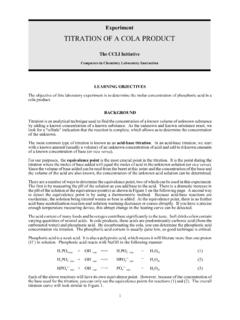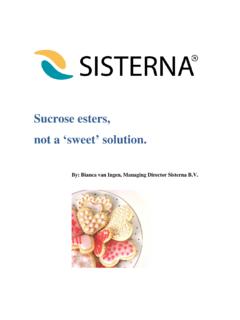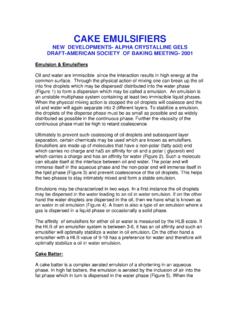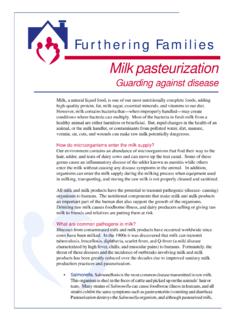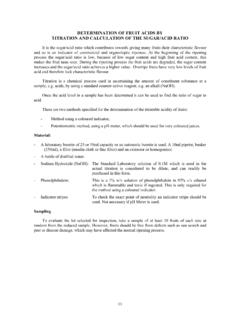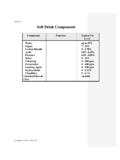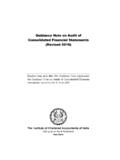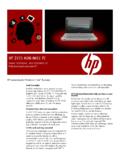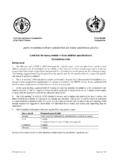Transcription of Process Application Note Sugar Inversion and Brix …
1 Process Application Note Paar High-precision Instruments Tel.: +43 (0)316 257-0 E-mail: Page 1 of 5 Sugar Inversion and Brix in Soft Drinks: Cobrix3 multibev Measures Both! 1. Introduction Soft drinks are produced from syrup (or concentrate), water and carbon dioxide. An important quality control parameter during production is the density of the syrup and the finished product, mainly reflecting the concentration of sweetener. For further details, see the Anton Paar's Process Application note On-line Density Measurement in the Soft Drink Industry [1].
2 Sugar (= saccharose = sucrose) is the traditional sweetener used for the production of soft drinks and is derived from cane or beets. Its concentration is given in Brix (= %w/w). Soft drink producers who use sucrose as the sweetener face the problem of Sugar Inversion : During storage, sucrose solutions undergo a slow conversion into a 1:1 mixture of glucose and fructose, also called invert Sugar . Each molecule of sucrose splits into one molecule of glucose and one molecule of fructose (see fig.)
3 1) at the same time consuming one molecule of water. This " Sugar Inversion " is enhanced by the presence of acids (contained in most beverages) and by elevated temperatures. Due to the Inversion Process , the density of the Sugar solution increases causing a considerable change in the Brix value from Brix (Brix-fresh) to Brix (Brix-inverted). Depending on Inversion degree the Brix value (Brix-actual) will lie between Brix-fresh value and Brix-inverted value. GlucoseH2 OGlucoseFructoseFructose+Sucroseinversio n Fig.
4 1 The Sugar Inversion Process The recipe for the production of a specific soft drink is either based on the sucrose concentration in the fresh product or total inverted product. Since the density of a Sugar solution increases during storage, density measurement does not give precise information about the real initial sucrose content. Fig. 2 Degree of Inversion over time Constant product quality of a soft drink greatly depends on the correct mixing ratio of the syrup with water.
5 This mixing ratio can only be determined if the original sucrose concentration ( Brix-fresh) or the glucose- und fructose concentration at complete Inversion (Brix-Inverted) of the syrup is known. The determination of Brix-fresh from partially or completely inverted syrups is therefore very important. For QC purposes the Brix-fresh or the Brix-inverted of finished products must also be determined. Since the density changes during storage depending on the degree of Inversion , Brix-fresh or Brix-inverted is the only meaningful result which can be used to compare different production batches.
6 100% time Brix Degree of Inversion 0% 10 Brix Brix Process Application Note Paar High-precision Instruments Tel.: +43 (0)316 257-0 E-mail: Page 2 of 5 2. Determination of Brix-fresh and Brix-inverted There are 2 ways to determine the Brix-fresh and Brix-inverted of an inverted sucrose solution: (1) The traditional Forced Inversion Method : All the sucrose is forced to invert fully by adding acid and increasing the temperature. The final solution contains invert Sugar (1:1 mixture of fructose and glucose).
7 By measuring the density using the corresponding tables it is possible to determine the invert Sugar concentration and calculate the original sucrose content (= Brix-fresh). (2) The more convenient Anton Paar Method : The density and sound velocity of the partially inverted sample are measured and Brix-fresh or Brix-inverted is automatically calculated using a special software. The principle of the calculation is described below [2]. Figure 3 shows the dependence of density and sound velocity on pure sucrose and invert Sugar concentrations with increasing concentration.
8 Fig. 3 Density and sound velocity dependent on sucrose and invert Sugar concentrations Partially inverted sucrose solutions contain both, invert Sugar and sucrose. The density and sound velocity measuring points are therefore located between the two lines. Fig. 4 Determining the Inversion compensated density To calculate the density of the initial sucrose solution, a line parallel to the Inversion line has to be drawn through this measuring point. The crossing point of this line with the sucrose line gives the density of the initial sucrose solution.
9 The crossing point of this line with the inverted Sugar line gives the density of completely inverted solution (see fig. 4.). The quality control of inverted Sugar solutions in the laboratory is carried out using the DSA 5000 Soft Drink Analyzer from Anton Paar. The Inversion compensation of the measured density and the calculation of Brix-fresh are performed automatically (see figure 3). For further information, see Anton Paar's Application note Sugar Inversion and Brix in Soft Drinks: DSA 5000 Measures Both!
10 [3]. For the on-line quality control of inverted soft drinks the Cobrix3 multibev beverage analyzer for Sugar Inversion is used. The Cobrix3 multibev measures density, sound velocity, temperature and CO2 content simultaneously. The measured density is compensated for temperature and CO2 (measured with the integrated CARBO 2100 CO2 transducer). The density reading is also compensated for Sugar Inversion using the sound velocity reading (see ). Process Application Note Paar High-precision Instruments Tel.
